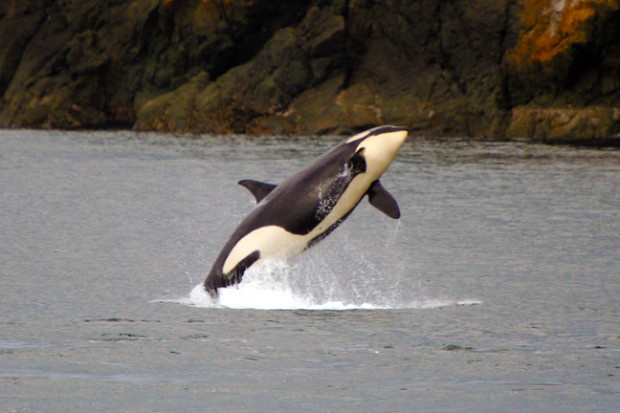We have much more to do and your continued support is needed now more than ever.
Orcas: How Science Debunked Superstition
From the depths of the briny blue abyss emerges a menacing Goliath—a colossus of the sea bent on revenge and destruction of the human race. Beware the open ocean for there lurks…Orca: The Killer Whale!
Sound like a cheesy movie tagline to a 1970’s blockbuster gone bust? Well, I took some poetic license but it’s not that far from the truth. On this day back in 1977, the movie Orca: The Killer Whale hit theaters promising just that—a man-eating Orca seeking retribution on the humans who killed his mate and unborn calf. Released just two years after the record-setting box office success of Jaws, this unfortunate bandwagon film failed to capture the same level of acclaim or money as its predecessor, but what it did accomplish was giving orcas a bad reputation as man-killing monsters.
A Bad Rap for Orcas

Growing to roughly the size of a school bus, there’s little doubt that these creatures are beasts of the sea, but that’s a far cry from blood-thirsty monster. To be fair, they are called “killer” whales (even though they are in fact related to dolphins) for a reason—they’re excellent and fierce predators in the marine world, but like many a tagline there’s more to this story.
In fact, orcas are quite social creatures, living in complex social structures known as pods. These pods are akin to wolf packs in their cooperative hunting techniques and familial bond. Each pod makes its own unique sounds that its members can recognize over great distances.
Orcas are extremely loyal and bonded to their family groups. They are very protective of their young and females often care for other whales’ offspring. Additionally, they all share responsibility in caring for their sick or injured.
As you can see, these social and emotive creatures are a far cry from the terrorizing beast billed in Orca: The Killer Whale, and though they are still wild, predatory mammals, they are far closer to Free Willy than Jaws.
Scientists are still learning new and exciting things about orcas and the very oceans in which they reside. Just recently, it was discovered that a rare breed of orca is likely an entirely different species. Unfortunately, the deeper we dive in getting to know these animals the more we are learning how our actions are endangering them.
Orcas on the Brink in Puget Sound
Coal exporting and proposed expansions to this industry are putting these majestic beasts smack-dab in the middle of dangers they are powerless to contend with. Evidence of this changing reality can be seen just off the shores of Puget Sound where Southern Resident Orcas are facing the stark realities of what coal exports mean to their habitat and welfare.
Today fewer than 90 individual orca whales inhabit the Puget Sound. These whales rely heavily on the population of salmon and other fish in for sustenance, but proposed coal export development threatens to disrupt the balance of this food chain. There are three proposed coal export terminals slated for the Puget Sound area, all of which would require extensive restricting of the immediate environment including: dredging, filling, construction of new pylons and shoreline grading.
What could all this mean for local wildlife?
- Habitat destruction
- Reduced salmon populations (due to the loss of shallow areas for young salmon to acclimate to salty waters)
- Diminished orca population because of reduced food availability
- Increased barge traffic which could result in direct harmful collisions with animals
- Coal dust and/or fuel leak contamination and reduction in the depth of sunlight penetration (or a shallower euphotic zone—the area which receives enough sunlight for photosynthesis to occur) which could lead to lower the oxygen content in the water.
Additionally, any increase in the burning of coal (and the subsequent release of one of some of the most harmful and potent greenhouse gases), would accelerate climate change. Climate change is already contributed to rising water temperatures that have caused massive die-offs in cold-water fish populations including salmon. It has also driven increased acidification of ocean waters also affecting salmon as well as smaller marine life. The burning of coal is also responsible for the release of mercury and other harmful pollutants into the food chain which are known to bioaccumulate (or become more highly concentrated) in the fatty tissues of animals as you climb the food chain. In short, if these projects are given the green light it could spell disaster for orcas.
Though orcas are renowned for their ability to communicate effectively and across vast distances, they cannot speak up for themselves in the fight against coal export expansion and other destructive man-made dangers.
![]() Please make a generous donation today to help fight for endangered orcas and many more wildlife.
Please make a generous donation today to help fight for endangered orcas and many more wildlife.
For more information on the dangers of coal exports to orcas and other marine life in Puget Sound, visit NWF.org/CoalExports.





















